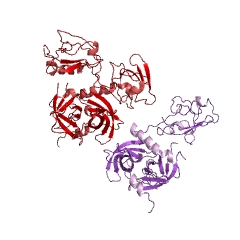peptidase Do EC#: 3.4.21.107; ChemWhat Code: 1380648
| Product Name | peptidase Do |
| Example Structure |  |
| Synonyms | bacterial PQC factor, BB_0104, BCAL2829, CD630_32840, Deg1, DEG2, DEG5, DEG7, DEG8, DegP, DegP protease, DegP/HtrA, DegQ, DegS, Do, Do protease, HhoA, HhoB, high temperature requirement A, high temperature requirement A protease, high temperature requirement A1, high temperature requirement factor A, high-temperature requirement A, high-temperature requirement A protease, high-temperature requirement A-1, high-temperature requirement A1, high-temperature requirement A1 protease, high-temperature requirement factor A, HtrA, HtrA (DegP) protease, HtrA heat shock protease, HtrA protease, HTRA serine peptidase 1, HtrA-like protease, HtrA/DegP, HtrA1, HtrA2, HtrA3, HTRA4, MAL8P1.126, More, MucD, Nma111p, Omi/HtrA protease orthologue Ynm3p, protease do, protease Do-like 5, protease Do-like 8, PRSS11, S01.273, serine protease, serine protease HtrA, serine protease HtrA1, YNL123w |
| EC Number | 3.4.21.107 |
| CAS Registry Number | 161108-11-8 |
| Comments | This serine endopeptidase is essential for the clearance of denatured or aggregated proteins from the inner-membrane and periplasmic space in?Escherichia coli. Natural substrates of the enzyme include colicin A lysis protein, pilin subunits and MalS from?E. coli?[3]. The enzyme has weak peptidase activity with casein and other non-native substrates [3]. The peptidase acts as a chaperone at low temperatures but switches to a peptidase (heat shock protein) at higher temperatures [1,6]. Molecular chaperones and peptidases control the folded state of proteins by recognizing hydrophobic stretches of polypeptide that become exposed by misfolding or unfolding. They then bind these hydrophobic substrates to prevent aggregation or assist in protein refolding. If attempts at refolding fail, then irreversibly damaged proteins are degraded by peptidases such as this enzyme [6]. Belongs in peptidase family?S1B. |
| Cofactor | |
| History | |
| Reactions | Acts on substrates that are at least partially unfolded. The cleavage site P1 residue is normally between a pair of hydrophobic residues, such as Val-|-Val. |
Buy Reagent | |
| No reagent supplier? | Send quick inquiry to ChemWhat |
| Want to be listed here as a reagent supplier? (Paid service) | Click here to contact ChemWhat |
Approved Manufacturers | |
| Want to be listed as an approved manufacturer (Requires approvement)? | Please download and fill out this form and send back to approved-manufacturers@chemwhat.com |
Other Suppliers | |
| Watson International Limited | Visit Watson Official Website |
Contact Us for Other Help | |
| Contact us for other information or services | Click here to contact ChemWhat |

